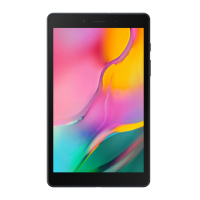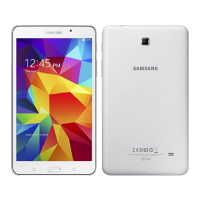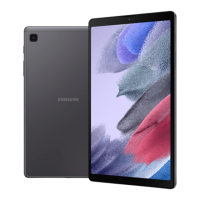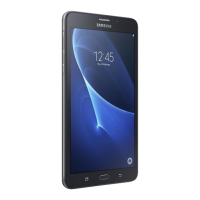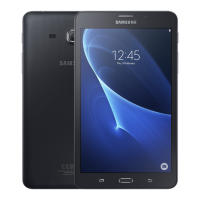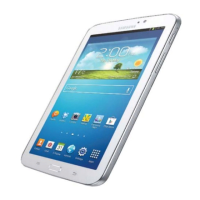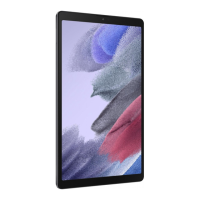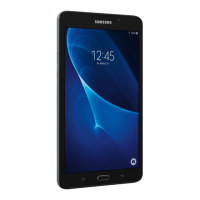Do you have a question about the Samsung SM-T295 and is the answer not in the manual?
Manual usage guidelines and important device information.
How to manage device heat-up during charging and use.
Overview of device components and their general functions.
Explains the function of navigation bar buttons on the screen.
Instructions and precautions for charging the device's battery.
Step-by-step guide for inserting the SIM or USIM card.
Steps for safely removing the SIM or USIM card from the device.
Guide for inserting a microSD card into the device.
Procedure for safely removing the memory card.
How to power the device on, off, and restart it.
Instructions to format a memory card for device compatibility.
Guide for the first-time setup of the device.
Instructions for signing into or creating a Samsung account.
How to transfer data from an old device to the new one.
Guidelines for interacting with the device's touchscreen.
Explanation of the on-screen navigation buttons.
Introduction to the device's main screens and their elements.
Guide to rearranging icons and widgets on the home screen.
How to group apps into folders for better organization.
Customizing wallpaper, widgets, and screen panels.
How to show all apps directly on the home screen.
Explanation of common icons displayed on the status bar.
How the lock screen works and how to unlock the device.
Steps to set or change screen lock types like PIN, pattern, or password.
How to take screenshots of the device screen.
How to view and interact with notifications.
Overview of the on-screen keyboard and text input.
How to switch between different keyboard languages.
Features like emoticons, stickers, GIFs, and voice input.
How to copy, cut, and paste text on the device.
How to look up word definitions directly on the device.
How to download, install, and remove applications from the device.
Uninstalling, disabling, enabling, and managing app permissions.
Step-by-step guide for making voice and video calls.
Making calls using call history, contacts, and speed dial numbers.
How to find and call nearby places like restaurants or stores.
Procedure for dialling phone numbers in other countries.
How to answer, reject, or send a rejection message for incoming calls.
How to add numbers to the block list and block unknown callers.
Features available during voice calls like add call, hold, mute, etc.
Features available during video calls like camera, mute, speaker.
How to save phone numbers to contacts.
Steps to create and save new contact information.
How to import contact information from other storage locations.
Syncing device contacts with online accounts like Samsung or Google.
Methods to find contacts in the device's contact list.
Options for sharing contact information with others.
How to organize contacts into groups.
Procedures for merging duplicates and deleting contacts.
How to send text messages and voice messages.
How to view conversations and reply to messages.
How to block messages from specific numbers.
Customizing notification sounds and display options.
How to delete individual or multiple messages.
How to use the internet browser to search and navigate websites.
How to activate and use the secret browsing mode.
Guide for configuring email accounts on the device.
How to compose, send, and read emails.
Different methods to open the camera application.
How to focus, adjust brightness, and capture photos.
Using the camera's automatic settings for easy photo capture.
How to take self-portraits and use beauty filters.
How to fix focus and exposure for consistent shots.
How to record videos and change screen ratio.
Taking photos with background blur for portrait effect.
Navigating and selecting various camera shooting modes.
Manual control over ISO, white balance, and exposure.
Using HDR for better detail and Panorama for wide scenes.
Applying stickers and taking rapid shots of moving subjects.
Adjusting delay, aspect ratio, filters, and metering.
Grid lines, location tags, editing modes, and contact info.
How to view photos stored in the Gallery app.
Selecting images, accessing options, and searching within the Gallery.
How to play videos and control playback features.
Accessing file details, people, location, and auto-created content.
Browsing photos and videos by type, favorites, or location.
Organizing and hiding photo/video albums.
How to create and manage stories from captured media.
Procedures for deleting stories, images, and videos.
How to manage deleted files using the recycle bin feature.
How to run two apps simultaneously in split screen mode.
How to resize app windows in split screen view.
How to run apps in floating pop-up windows.
Support services, community, news, and tips from Samsung.
How to create notes using text, handwriting, or drawings.
How to delete notes from the Samsung Notes app.
How to add and manage events and tasks in the calendar.
Syncing calendar data with online accounts.
Accessing and managing files stored on the device or cloud.
How to set, stop, and delete alarms using the Clock app.
Using features for time zones, timing events, and countdowns.
Performing calculations and unit conversions.
How to activate and configure the Kids Home environment.
Selecting apps and managing parental controls within Kids Home.
How to share images and other content via various methods.
Browsing the internet and searching for information.
Sending and receiving emails via the Google Mail service.
Finding locations and navigating the world.
Listening to music and watching videos.
Storing and accessing files on the cloud.
Watching and sharing videos.
Searching, managing, and editing photos and videos.
Using Google for search and making video calls.
Overview of device customization through settings.
Settings for Wi-Fi, Bluetooth, and flight mode.
Connecting the device to Wi-Fi networks.
Sharing files directly between devices using Wi-Fi Direct.
Steps to connect the device with other Bluetooth devices.
Sharing files and data using Bluetooth.
How to disconnect paired Bluetooth devices.
Reducing data usage by limiting background app activity.
Setting apps to use only mobile data, even on Wi-Fi.
Sharing the device's mobile data connection.
Steps to set up and use the device as a Wi-Fi hotspot.
Customizing nearby device scanning, VPN, and DNS settings.
Setting up and printing documents from the device.
Installing software for printer compatibility.
Adjusting ringtones, notification sounds, and volume levels.
Enhancing audio experience with surround sound modes.
Customizing app icon badges and Do Not Disturb mode.
Adjusting brightness, adaptive brightness, and night mode.
Applying a dark theme to reduce eye strain.
Changing screen modes and optimizing color balance.
Fine-tuning screen color tones using RGB values.
Setting up images to display when the device is charging.
Changing the device's home and lock screen backgrounds.
Customizing screen lock type, clock style, and notifications.
Setting up automatic device unlocking based on location or trusted devices.
Managing device security features like Google Play Protect and Find My Mobile.
Managing app installations and encrypting memory cards.
Location, app permissions, and diagnostic data settings.
Syncing accounts, managing users, and backing up data.
Steps to create and set up new user accounts.
How to switch between different user profiles.
Deleting accounts or changing account settings.
How to sync device data like events to Samsung Cloud.
Procedures for backing up and restoring device data to Samsung Cloud.
Configuring settings for Google services.
Smart pop-up view, direct share, and reduce animations.
Activating motion features like Smart Stay and swipe gestures.
Limiting daily app usage time with timers.
Reducing eye strain and sleep disturbance with wind down mode.
Overview of battery, storage, memory, and security status.
Quick optimization actions for performance improvement.
Setting the device to optimize automatically when not in use.
Selecting power saving modes like Optimized, Medium, or Maximum.
Putting apps to sleep to save battery power.
Checking used and available memory status.
Clearing cache, deleting files, and uninstalling apps.
Checking the device's security status and scanning for malware.
Managing apps, notifications, and permissions.
Customizing device languages, keyboards, and voice input.
Adjusting how the device displays time and date.
How to add and manage multiple languages for the device.
Configuring settings for improved device accessibility.
Updating the device's software via FOTA service.
Accessing help information for device and app usage.
Viewing device information like status, legal, software, and battery.
What to do when prompted for codes during device use.
How to resolve common network connectivity issues.
Troubleshooting steps when the device fails to power on.
Solutions for slow or improper touchscreen response.
Steps to restart or reset the device when it freezes.
Troubleshooting when calls cannot be connected.
Resolving problems with sound echoes or being unheard.
Troubleshooting poor cellular/internet connection or audio quality.
What to do when the battery icon indicates low power.
Troubleshooting when the battery does not charge properly.
Explaining why battery life might decrease over time.
Resolving errors when opening the camera app.
Tips for improving photo quality and avoiding noise.
Resolving errors with opening or playing multimedia files.
Troubleshooting Bluetooth connection problems.
Troubleshooting connection problems with computers.
Solutions for when the device cannot find the current location.
Advice on data backup and freeing up storage space.
Troubleshooting missing Apps or Home buttons.
How to show the screen brightness bar on the notification panel.
Troubleshooting when Samsung Cloud service is unavailable.
Warning against self-removal and contact info for service.
Manual usage guidelines and important device information.
How to manage device heat-up during charging and use.
Overview of device components and their general functions.
Explains the function of navigation bar buttons on the screen.
Instructions and precautions for charging the device's battery.
Step-by-step guide for inserting the SIM or USIM card.
Steps for safely removing the SIM or USIM card from the device.
Guide for inserting a microSD card into the device.
Procedure for safely removing the memory card.
How to power the device on, off, and restart it.
Instructions to format a memory card for device compatibility.
Guide for the first-time setup of the device.
Instructions for signing into or creating a Samsung account.
How to transfer data from an old device to the new one.
Guidelines for interacting with the device's touchscreen.
Explanation of the on-screen navigation buttons.
Introduction to the device's main screens and their elements.
Guide to rearranging icons and widgets on the home screen.
How to group apps into folders for better organization.
Customizing wallpaper, widgets, and screen panels.
How to show all apps directly on the home screen.
Explanation of common icons displayed on the status bar.
How the lock screen works and how to unlock the device.
Steps to set or change screen lock types like PIN, pattern, or password.
How to take screenshots of the device screen.
How to view and interact with notifications.
Overview of the on-screen keyboard and text input.
How to switch between different keyboard languages.
Features like emoticons, stickers, GIFs, and voice input.
How to copy, cut, and paste text on the device.
How to look up word definitions directly on the device.
How to download, install, and remove applications from the device.
Uninstalling, disabling, enabling, and managing app permissions.
Step-by-step guide for making voice and video calls.
Making calls using call history, contacts, and speed dial numbers.
How to find and call nearby places like restaurants or stores.
Procedure for dialling phone numbers in other countries.
How to answer, reject, or send a rejection message for incoming calls.
How to add numbers to the block list and block unknown callers.
Features available during voice calls like add call, hold, mute, etc.
Features available during video calls like camera, mute, speaker.
How to save phone numbers to contacts.
Steps to create and save new contact information.
How to import contact information from other storage locations.
Syncing device contacts with online accounts like Samsung or Google.
Methods to find contacts in the device's contact list.
Options for sharing contact information with others.
How to organize contacts into groups.
Procedures for merging duplicates and deleting contacts.
How to send text messages and voice messages.
How to view conversations and reply to messages.
How to block messages from specific numbers.
Customizing notification sounds and display options.
How to delete individual or multiple messages.
How to use the internet browser to search and navigate websites.
How to activate and use the secret browsing mode.
Guide for configuring email accounts on the device.
How to compose, send, and read emails.
Different methods to open the camera application.
How to focus, adjust brightness, and capture photos.
Using the camera's automatic settings for easy photo capture.
How to take self-portraits and use beauty filters.
How to fix focus and exposure for consistent shots.
How to record videos and change screen ratio.
Taking photos with background blur for portrait effect.
Navigating and selecting various camera shooting modes.
Manual control over ISO, white balance, and exposure.
Using HDR for better detail and Panorama for wide scenes.
Applying stickers and taking rapid shots of moving subjects.
Adjusting delay, aspect ratio, filters, and metering.
Grid lines, location tags, editing modes, and contact info.
How to view photos stored in the Gallery app.
Selecting images, accessing options, and searching within the Gallery.
How to play videos and control playback features.
Accessing file details, people, location, and auto-created content.
Browsing photos and videos by type, favorites, or location.
Organizing and hiding photo/video albums.
How to create and manage stories from captured media.
Procedures for deleting stories, images, and videos.
How to manage deleted files using the recycle bin feature.
How to run two apps simultaneously in split screen mode.
How to resize app windows in split screen view.
How to run apps in floating pop-up windows.
Support services, community, news, and tips from Samsung.
How to create notes using text, handwriting, or drawings.
How to delete notes from the Samsung Notes app.
How to add and manage events and tasks in the calendar.
Syncing calendar data with online accounts.
Accessing and managing files stored on the device or cloud.
How to set, stop, and delete alarms using the Clock app.
Using features for time zones, timing events, and countdowns.
Performing calculations and unit conversions.
How to activate and configure the Kids Home environment.
Selecting apps and managing parental controls within Kids Home.
How to share images and other content via various methods.
Browsing the internet and searching for information.
Sending and receiving emails via the Google Mail service.
Finding locations and navigating the world.
Listening to music and watching videos.
Storing and accessing files on the cloud.
Watching and sharing videos.
Searching, managing, and editing photos and videos.
Using Google for search and making video calls.
Overview of device customization through settings.
Settings for Wi-Fi, Bluetooth, and flight mode.
Connecting the device to Wi-Fi networks.
Sharing files directly between devices using Wi-Fi Direct.
Steps to connect the device with other Bluetooth devices.
Sharing files and data using Bluetooth.
How to disconnect paired Bluetooth devices.
Reducing data usage by limiting background app activity.
Setting apps to use only mobile data, even on Wi-Fi.
Sharing the device's mobile data connection.
Steps to set up and use the device as a Wi-Fi hotspot.
Customizing nearby device scanning, VPN, and DNS settings.
Setting up and printing documents from the device.
Installing software for printer compatibility.
Adjusting ringtones, notification sounds, and volume levels.
Enhancing audio experience with surround sound modes.
Customizing app icon badges and Do Not Disturb mode.
Adjusting brightness, adaptive brightness, and night mode.
Applying a dark theme to reduce eye strain.
Changing screen modes and optimizing color balance.
Fine-tuning screen color tones using RGB values.
Setting up images to display when the device is charging.
Changing the device's home and lock screen backgrounds.
Customizing screen lock type, clock style, and notifications.
Setting up automatic device unlocking based on location or trusted devices.
Managing device security features like Google Play Protect and Find My Mobile.
Managing app installations and encrypting memory cards.
Location, app permissions, and diagnostic data settings.
Syncing accounts, managing users, and backing up data.
Steps to create and set up new user accounts.
How to switch between different user profiles.
Deleting accounts or changing account settings.
How to sync device data like events to Samsung Cloud.
Procedures for backing up and restoring device data to Samsung Cloud.
Configuring settings for Google services.
Smart pop-up view, direct share, and reduce animations.
Activating motion features like Smart Stay and swipe gestures.
Limiting daily app usage time with timers.
Reducing eye strain and sleep disturbance with wind down mode.
Overview of battery, storage, memory, and security status.
Quick optimization actions for performance improvement.
Setting the device to optimize automatically when not in use.
Selecting power saving modes like Optimized, Medium, or Maximum.
Putting apps to sleep to save battery power.
Checking used and available memory status.
Clearing cache, deleting files, and uninstalling apps.
Checking the device's security status and scanning for malware.
Managing apps, notifications, and permissions.
Customizing device languages, keyboards, and voice input.
Adjusting how the device displays time and date.
How to add and manage multiple languages for the device.
Configuring settings for improved device accessibility.
Updating the device's software via FOTA service.
Accessing help information for device and app usage.
Viewing device information like status, legal, software, and battery.
What to do when prompted for codes during device use.
How to resolve common network connectivity issues.
Troubleshooting steps when the device fails to power on.
Solutions for slow or improper touchscreen response.
Steps to restart or reset the device when it freezes.
Troubleshooting when calls cannot be connected.
Resolving problems with sound echoes or being unheard.
Troubleshooting poor cellular/internet connection or audio quality.
What to do when the battery icon indicates low power.
Troubleshooting when the battery does not charge properly.
Explaining why battery life might decrease over time.
Resolving errors when opening the camera app.
Tips for improving photo quality and avoiding noise.
Resolving errors with opening or playing multimedia files.
Troubleshooting Bluetooth connection problems.
Troubleshooting connection problems with computers.
Solutions for when the device cannot find the current location.
Advice on data backup and freeing up storage space.
Troubleshooting missing Apps or Home buttons.
How to show the screen brightness bar on the notification panel.
Troubleshooting when Samsung Cloud service is unavailable.
Warning against self-removal and contact info for service.
| Model | SM-T295 |
|---|---|
| RAM | 2 GB |
| Storage | 32 GB |
| Battery | 5100 mAh |
| Colors | Black, Silver |
| Display | 8.0 inches, 800 x 1280 pixels |
| Processor | Qualcomm Snapdragon 429 |
| Expandable Storage | MicroSD (Up to 512GB) |
| Rear Camera | 8 MP |
| Front Camera | 2 MP |
| Operating System | Android 9.0 (Pie) |
| Dimensions | 210.0 x 124.4 x 8.0 mm |
| Weight | 347 g |
| Connectivity | Wi-Fi 802.11 a/b/g/n |
| Bluetooth | 4.2 |
| USB | USB 2.0, USB Type-C |
| Sensors | Accelerometer |
